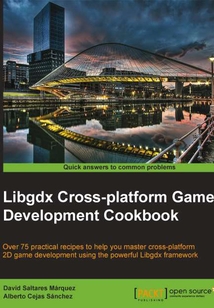舉報 

會員
Libgdx Cross/platform Game Development Cookbook
最新章節:
Index
Ifyouwanttomakecross-platformgameswithoutthehassleanddangersofwritingplatform-specificcode,orIfyouareagameprogrammerwhomayhavesomeexperiencewithJavaandyouwanttolearneverythingyouneedtoknowaboutLibgdxtoproduceawesomework,thisisthebookforyou.Totakefulladvantageoftherecipesinthisbook,youareexpectedtobefamiliarwithjavawithgoodgameprogrammingknowledge.
目錄(120章)
倒序
- coverpage
- Libgdx Cross-platform Game Development Cookbook
- Credits
- About the Authors
- About the Reviewers
- www.PacktPub.com
- Support files eBooks discount offers and more
- Preface
- What this book covers
- What you need for this book
- Who this book is for
- Conventions
- Reader feedback
- Customer support
- Chapter 1. Diving into Libgdx
- Introduction
- Setting up a cross-platform development environment
- Creating a cross-platform project
- Understanding the project structure and application life cycle
- Updating and managing project dependencies
- Using source control on a Libgdx project with Git
- Importing and running the Libgdx official demos
- Chapter 2. Working with 2D Graphics
- Introduction
- Texture rendering with SpriteBatch
- More effective rendering with regions and atlases
- Taking advantage of Libgdx sprites
- Rendering sprite-sheet-based animations
- Understanding orthographic cameras
- Using ShapeRenderer for debug graphics
- Handling multiple screen sizes with viewports
- Chapter 3. Advanced 2D Graphics
- Introduction
- Achieving juicy effects with particles
- Frame buffers and image composition
- Welcome to the world of shaders
- Passing parameters into shader programs
- 2D depth of field shader
- Embedding a Libgdx window into a Java desktop application
- Chapter 4. Detecting User Input
- Introduction
- Detecting user input via event polling
- Detecting user input via event listening
- Managing multiple listeners at once
- Detecting more complex gestures
- Introducing the controllers API
- Input mapping for cross-platform development
- Chapter 5. Audio and File I/O
- Introduction
- Playing short sound effects
- Audio streaming for background music
- Optimizing audio files to reduce download sizes
- Procedural audio generators
- Engine sounds with dynamic audio
- The 2D space sound system
- The first approach to file handling in Libgdx
- Using preferences to store game states and options
- The XML parsing primer
- JSON serialization and deserialization
- Chapter 6. Font Rendering
- Introduction
- Generating and rendering bitmap fonts
- Baking effects into fonts using Hiero
- Scaling friendly font rendering with distance fields
- Dynamic font effects using distance fields
- Chapter 7. Asset Management
- Introduction
- Getting to know AssetManager
- Asynchronous asset loading
- Creating custom asset loaders
- Managing groups of assets for bigger games
- Chapter 8. User Interfaces with Scene2D
- Introduction
- Introducing the Scene2D API
- Widget collection overview
- Creating a basic menu screen using tables
- Skin customization
- Creating new widgets
- Chapter 9. The 2D Maps API
- Introduction
- Creating maps with Tiled and loading them into Libgdx
- Adding and querying map metadata
- Developing your own map loaders and renderers
- Chapter 10. Rigid Body Physics with Box2D
- Introduction
- Introducing Box2D
- Introducing more complex shapes
- Introducing joints
- Real-life joints example – bike simulator
- Reacting to collisions
- Sensors and collision filtering
- Querying the world
- Building a physics world from level data
- Implementing a deferred raycaster
- The fixed timestep approach
- Chapter 11. Third-party Libraries and Extras
- Introduction
- Making libraries compatible with GWT
- Managing platform-specific code
- Smooth animations with Universal Tween Engine
- Dynamic 2D lighting with Box2DLights
- Adding support for localization
- Finite state machine and messaging
- Component-based entity systems with Ashley
- Skeletal animations with Spine
- Chapter 12. Performance and Optimizations
- Introduction
- Profiling your application with VisualVM
- Using Libgdx features to avoid garbage collection
- Avoiding unnecessary render calls with frustum culling
- Chapter 13. Giving Back
- Introduction
- Releasing your Libgdx game on desktop
- Releasing your Libgdx game on Android
- Releasing your Libgdx game on iOS
- Releasing your Libgdx game on browsers
- Working from sources
- Creating a new test for your fresh feature
- Sending a pull request on GitHub
- Index 更新時間:2021-04-02 20:34:14
推薦閱讀
- GitHub Essentials
- 大數據技術基礎
- Effective Amazon Machine Learning
- App+軟件+游戲+網站界面設計教程
- 新型數據庫系統:原理、架構與實踐
- 云計算服務保障體系
- Oracle高性能自動化運維
- MATLAB Graphics and Data Visualization Cookbook
- 計算機應用基礎教程上機指導與習題集(微課版)
- 數據科學工程實踐:用戶行為分析與建模、A/B實驗、SQLFlow
- Unity 2018 By Example(Second Edition)
- 從實踐中學習sqlmap數據庫注入測試
- 大數據時代系列(套裝9冊)
- 數據指標體系:構建方法與應用實踐
- Scratch 2.0 Game Development HOTSHOT
- Visual Studio 2012 and .NET 4.5 Expert Development Cookbook
- 數據挖掘與機器學習-WEKA應用技術與實踐(第二版)
- 數據中心UPS系統運維
- 產品經理數據修煉30問
- Working with OpenERP
- 工業大數據工程:系統、方法與實踐
- Unity iOS Essentials
- 基于MATLAB的試驗設計和數據處理
- XNA 4 3D Game Development by Example:Beginner's Guide
- Hands-On Design Patterns with Java
- Implementing DevOps with Microsoft Azure
- 計算機應用基礎(微課版)
- Spark全棧數據分析
- Python Reinforcement Learning
- 大學計算機基礎(第2版)

